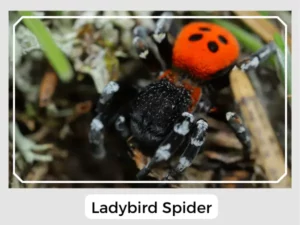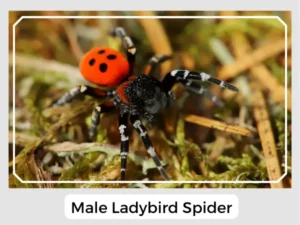The ladybird spider is a pretty spider from the velvet spider family. It lives in northern and central parts of Europe. Male spiders look a lot like ladybirds, and that’s how they got their fun name. Ready to know more about this colorful spider? We have some awesome facts to share!
Female ladybird spiders lay 35-40 eggs, wrapping them carefully in silk.
After emerging from the eggs, hatchlings are fed on a special liquid provided by their mother. Interestingly, the female spider lets herself die by digesting her body parts. Then the spiderlings suck on the body to keep themselves well-fed. Male spiderlings develop into adults when they are three, while the females could take a year longer.
They make messy webs, sometimes even decorating them with the insect’s bodies that they prey upon.
Yes, Ladybird Spiders have venom. They mainly use it to catch their tiny snacks.
They can bite, but they’re usually very peaceful. If they feel cornered or super scared, they might defend themselves with a bite. But most of the time, they’re just colorful and curious spiders!

Photo Credit: Erland Nielsen
Ladybird Spiders are valuable predators in their habitats, feeding on a variety of insects, which helps in controlling pest populations. Their unique mating and reproductive behaviors, such as the self-sacrifice of the female for her offspring, highlight the complex life cycles within the arachnid world.
Natural Predators: Despite their venomous bite, Ladybird Spiders fall prey to larger insects, birds, and small mammals. Their survival is also threatened by habitat loss and changes in their environment.
Prey-Predator Dynamics: The venom of the Ladybird Spider is crucial for immobilizing prey, allowing these small predators to contribute to the health of their ecosystem by regulating insect populations.
Relationship with Humans: Ladybird Spiders, while venomous, are not aggressive towards humans and bites are exceedingly rare. They are often admired for their unique appearance but face threats from habitat destruction and the illegal pet trade.
| Distribution | Northern Italy, Southern Norway, and England |
| Habitat | South-facing slopes that are sheltered |
| Diet | Insects |
| Web-type | Messy and no particular pattern followed |
| IUCN Conservation Status | Not Listed |

Photo Credit: Erland Nielsen
In summary, the Ladybird Spider is not only a species of aesthetic interest but also an ecological asset to its natural surroundings.
The ladybird spider is a pretty spider from the velvet spider family. It lives in northern and central parts of Europe. Male spiders look a lot like ladybirds, and that’s how they got their fun name. Ready to know more about this colorful spider? We have some awesome facts to share!
Female ladybird spiders lay 35-40 eggs, wrapping them carefully in silk.
After emerging from the eggs, hatchlings are fed on a special liquid provided by their mother. Interestingly, the female spider lets herself die by digesting her body parts. Then the spiderlings suck on the body to keep themselves well-fed. Male spiderlings develop into adults when they are three, while the females could take a year longer.
They make messy webs, sometimes even decorating them with the insect’s bodies that they prey upon.
Yes, Ladybird Spiders have venom. They mainly use it to catch their tiny snacks.
They can bite, but they’re usually very peaceful. If they feel cornered or super scared, they might defend themselves with a bite. But most of the time, they’re just colorful and curious spiders!

Photo Credit: Erland Nielsen
Ladybird Spiders are valuable predators in their habitats, feeding on a variety of insects, which helps in controlling pest populations. Their unique mating and reproductive behaviors, such as the self-sacrifice of the female for her offspring, highlight the complex life cycles within the arachnid world.
Natural Predators: Despite their venomous bite, Ladybird Spiders fall prey to larger insects, birds, and small mammals. Their survival is also threatened by habitat loss and changes in their environment.
Prey-Predator Dynamics: The venom of the Ladybird Spider is crucial for immobilizing prey, allowing these small predators to contribute to the health of their ecosystem by regulating insect populations.
Relationship with Humans: Ladybird Spiders, while venomous, are not aggressive towards humans and bites are exceedingly rare. They are often admired for their unique appearance but face threats from habitat destruction and the illegal pet trade.
| Distribution | Northern Italy, Southern Norway, and England |
| Habitat | South-facing slopes that are sheltered |
| Diet | Insects |
| Web-type | Messy and no particular pattern followed |
| IUCN Conservation Status | Not Listed |

Photo Credit: Erland Nielsen
In summary, the Ladybird Spider is not only a species of aesthetic interest but also an ecological asset to its natural surroundings.